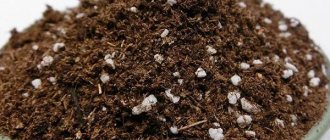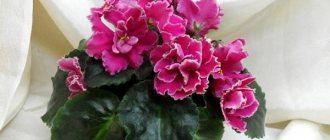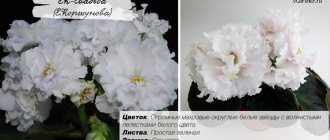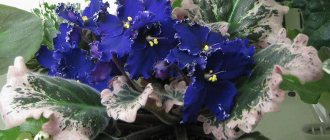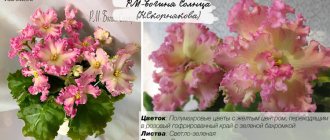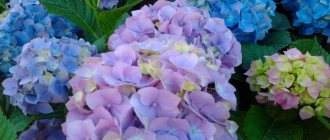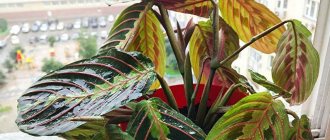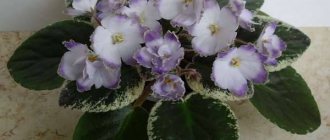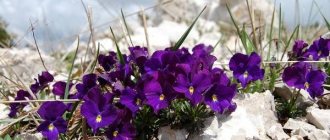Today, varietal Uzambara violets, based on the shape of the flowers, their color, type and size of the rosette, are divided into many groups worthy of consideration and study. After all, just the names of varieties of violets and their photos make the hearts of connoisseurs of living beauty beat faster.
Violet Black Pearl
The double flowers of the Black Pearl violet, obtained by the famous breeder E. Korshunova, are distinguished by their extraordinary size and thick purple-violet color with a noble velvety tint. A single flower at the stage of full dissolution can reach 7 cm in diameter, while the plant forms an inflorescence-cap consisting of 6–8 corollas. The standard-sized rosette consists of simple dark green leaves, against which dense pom-poms of flowers look even more solemn.
Care and maintenance of violets
When caring for violets, the following conditions must be observed:
- Bright light is the main thing for maintaining a flower. The abundance of flowering and the brightness of the color of the flowers depend on the illumination. But violet does not tolerate direct sunlight. They cause burns, which are expressed in the appearance of yellow spots on the leaves and flowers. Plants that bloom with white flowers are most susceptible to burns.
- Place on the windowsill. Violet Tristan will grow on any windowsill, but it is preferable to choose windows on the north side. It should be noted that the evening rays of the setting sun will not harm the violet. If it happens that you only have south and west windows, then you need to do shading. To do this, you need to stick a sheet of tracing paper on the bottom of the glass or hang a curtain made of thick tulle. It will let in enough light and protect the plants from direct sunlight.
- Flowering all year round. To do this, it is necessary to use artificial lighting for at least 12 hours a day. The air temperature should be at least 18 degrees, and the plants should not be exposed to drafts. Lighting will not have any effect on the Tristan violet if the temperature drops below 15 degrees.
- Protect from cold. In winter, on cold window sills, it is advisable to cover pots with plants with any material with thermal insulation, while slightly limiting watering.
Having assessed all the conditions in the apartment, you can place the violets in a place suitable for them. And they, in turn, will thank you with the beauty of their flowers and will bloom all year round.
Violet Wedding bouquet
Photo of violets A wedding bouquet in full bloom evokes involuntary admiration among many amateur gardeners. Indeed, having seen a plant only once, you cannot refuse the desire to see this miracle on your windowsill. The variety obtained by Konstantin Morev forms a rosette of standard sizes. The leaves are simple, pubescent, and have a beautiful green hue. The flowers are semi-double or simple, extremely large. The flowers are given a special airiness by a bluish shadow at the base and a wide corrugated edge. The inflorescence leaves the feeling of a bouquet worthy of a bride.
Violet Tristan: photo and description of the variety
Tristan is one of the varieties of indoor violets that has an unusual and delightful appearance. Many gardeners manage to successfully grow this variety. The plant has white flowers with edges of a corrugated structure, on which there are strokes of purple and hot pink. Small socket. The flower looks great, you can hardly take your eyes off it. Leaves with slightly wavy edges of a light shade. Their surface can be semi-double or regular structure. To maintain a violet in a constant blooming state, as mentioned earlier, it needs bright light, a constant temperature of at least 18 degrees, normal air humidity, proper watering and timely replanting twice a year.
Violet Red River
Ampel Saintpaulia or Uzambara violet, bred by N. Andreeva, blooms in abundance with 3-centimeter semi-double flowers of an unusual red hue for the culture. According to the author's description, the flowering of the Red River violet will be more intense and vibrant if the plant is located in a well-lit place.
Closer to wilting, the corollas acquire a lilac or crimson color. A characteristic feature of the variety is active growth and unusual foliage color. On the green background, and especially along the edge of the leaf rosette, golden touches are clearly visible.
Violet flower. Description and care of violets
Violet was cultivated in ancient Greece. The first mention of the plant dates back to the 500s BC. The Greeks worshiped purple flowers, considering them a symbol of fertility and love.
To prevent these phenomena from passing them by, the inhabitants of the country added violet petals to wine, food, and love potions. In the 21st century, the plant is mainly used for indoor decoration. Whether the violet still has any hidden roles, and what the characteristics of the flower are, we will find out further.
Features of violet
Violet is a plant of the Violet family. All types of flower are perennial herbs growing from 15 to 40 centimeters. Varieties of violets are also united by the structure of the rhizome. It is thick and woody. Plant stems are shortened. Their growth is so slow that the emerging leaves are located close to each other, folding into rosettes.
The root is not only greenery, but also flower stalks of violets . Photos of plants begin to be taken in the spring. At this time, the first buds open. They are solitary, consisting of 5 lanceolate or ovoid petals. The violet leaves are also rounded . They are solid, with oval or heart-shaped contours. There are small notches along the edge.
Violet greens can be smooth or velvety. Short hairs cover the foliage of about half the plant species. There are varieties in which the petals of the buds are also pubescent.
By autumn, violet flowers turn into boxes with seeds. They are oblong, ovoid, smooth. In order for the seeds to spill out onto the ground, 3 doors must open. Domestic violet seeds are used only for propagation of the crop. The stems, leaves and flowers are also suitable for medicine. They are good against inflammation and as antiseptics, helping with colds, kidney ailments, and gastrointestinal tract.
The medicinal properties of the flower are due to the substances it accumulates. Indoor violet contains carotene, rutin, salicylic acid and vitamin C. The tissue composition also contains glycosides. All these elements are necessary for the health of the body.
True, violets also have contraindications: hepatitis and glomerulonephritis. It wouldn’t hurt to consult a doctor even if there are no prohibitions. Exceeding the dosage, or using decoctions for too long, leads to nausea, vomiting, and loose stools.
Coma biological, food, medicinal, violet also has a symbolic description. So, in France, a flower is a sign of constancy, eternal love. The peoples of Scandinavia revere the violet as a symbol of innocence and modesty. In Ancient Rome, the plant was associated with Jupiter - the God of Gods. So, from the Romans' point of view, the queen of flowers is not the rose, but the violet.
About 30 of the 600 plant species are grown at home Botanists divide them into 16 genera. According to their purpose, they are divided into wild or forest, garden and indoor. Let's consider options suitable for cultivation at home.
Types of violets
The most popular among gardeners is night violet . More often it is called dark. The reason is the purple-black color. It is strengthened by the fact that the buds are collected in inflorescences of 4 pieces. The yellow anthers of the stamens look impressive against a dark background. There are 5 of them in each bud.
One of the Russian TV series is also called Night Violet. It tells the story of the relationship between a wealthy businessman and a girl he rescued from a brothel. The heroine's name is Rita. She accepts the advances of her benefactor. The intrigue is that the girl begins to have feelings for someone else.
Those who once fell in love with the violet plant, as a rule, no longer change their passion. Some choose wild species, others choose selective ones. Dark varieties belong to the latter, like violet le . This name hides the abbreviation of the name Elena Lebetskaya. She has been developing new varieties for 15 years.
The woman created more than 250 previously unseen varieties. All of them are intended for indoor floriculture. A special feature of Elena’s varieties are the buds of the terry type, with fringe or fancy coloring.
Fans of wild species usually choose Altai species. The homeland of these violets is Russia. Although, most of the flowers in the family are African. Altai shoots are distinguished by triangular stems and single planted buds. They are blue-violet, based on long petioles. The diameter of the flowers is about 3 centimeters.
Altai violet reaches 20 centimeters. Those who want to have an even smaller plant, but untouched by selection, pay attention to the mountain species. This violet requires careful care at home .
In particular, shoots need coolness, just like in the mountains. Flower growers try to satisfy requests, because the effort is worth it. A “carpet” of shoots only 5 centimeters high blooms in pots. The buds on them bloom large, blue or purple.
The buds of the graceful violet are yellow . Copies of it are rarely made from beads The species is known only to botanists and avid gardeners. The height of the shoots is from 10 to 20 centimeters. The diameter of the buds is approximately 4 centimeters. The graceful violet blooms from spring to autumn, which is unusual for representatives of the genus.
In general, about one and a half thousand varieties are grown at home. These are the same 30 species. Only the most popular ones are listed. By the way, hybrids and selection samples are usually called Saintpaulias. The wild variants of the plant are called violets. But the rules for caring for both are the same. Let's find out how to care for the selected flowers.
Caring for violets at home
Before you buy violets , you need to find a well-lit place for them. Contrary to the ancient Greek legend, flowers love the sun's rays, albeit scattered. The legend says that the daughter of Atlas became a violet.
The forest nymph was harassed by Apollo, but the girl did not like his attention. She asked Zeus for protection. He took pity, turning the nymph into a violet and hiding her in the darkest corner of the forest so that her admirer would not find her.
Along with light, violets require high humidity. Therefore, many gardeners place plants in kitchens. Evaporation from cooking, washing dishes, and boiling water helps violets feel comfortable. If the pots are in living rooms, an air humidifier or trays with water placed near the plants are required.
Moderate watering for violets is recommended. The pot must have a solid layer of expanded clay in order to protect the plants from stagnant water. As for the substrate, flower shops have specialized soil.
You can assemble the mixture yourself. Ordinary garden soil with added sand will do. The composition is processed in the oven or microwave. This kills fungal spores and other pests.
Violet price
“The Violet House” is free. This is not about the real building, but about the film. In it, a family acquires an estate with a flower garden and a bad reputation. If your plans are not to watch the series, but to buy a real plant, it will cost 200-500 rubles. This is the price tag of flower shops. Offers are also received from individuals in the amount of 50-100 rubles.
Ads should be searched on the Internet. There are also websites of private sellers who grow violets personally, like Elena Lebetskaya. On such resources the prices are also not bad, starting from the same 50 rubles. However, if delivery is required, you will have to pay extra.
Violet Rosie Ruffles
The Rosie Ruffles violet, bred by D. Harrington, is a standard sized rosette consisting of pubescent green leaves with a wavy shape. The main advantage of the variety is its large star-shaped flowers. The color of the flowers is a light fuchsia shade. The edge is densely corrugated, lace.
Often gardeners are faced with the fact that children and rooted tops of rosettes do not retain the wavy edge of the petals inherent in the variety, and the decorative effect does not return as Saintpaulia grows. But when you place Rosie Ruffles violet plants on a cool windowsill, you can get a bright green border on the flowers.
Humidity and watering
Increased temperature in the apartment when growing violets leads to dry air and soil, which has a detrimental effect on the plants. To maintain normal humidity, spray near the flower from time to time or place a container of water filled with pebbles. Watering is carried out as the soil dries, only warm water is used. A sufficient amount of water for the plant's root system guarantees its health and active growth.
During the growth period (all spring and summer), the violet’s need for water increases. It is necessary to water the plant when the top layer of soil dries out by 1.5 cm. In this case, Saintpaulia will never experience stagnation of water, which adversely affects the condition of the plant.
Violet Lituanica
The delicate pink flowers of the Lituanica violet will not leave any lover of this indoor plant indifferent. The variety selected by Butene forms a standard rosette of pointed, medium-sized leaves of an even, green color.
Due to their elongated petals, double flowers resemble dahlias in shape, and the corollas are made more unusual by the richer color of the tips of the petals. A very beautiful plant, named Lituanica in honor of the plane that took part in the flight from America to Kaunas in 1933. Lituanica violet blooms profusely, but grows rather slowly as the rosette matures.
Variety and sport of violets
Often, when growing the Tristan violet, the photo and description of which this article is devoted to, surprises arise - the plant blooms in the wrong variety. The color of the flower, and sometimes even the leaves, differ from the original. Breeders have bred many magnificent violets that perfectly pass on their varietal characteristics by inheritance. But there are also variants of sporting, when the grown children do not retain all the varietal properties of their parents. In this case, plants are called sports. This often happens in fantasy varieties, which include the Tristan violet. Some sports look more attractive than their parents and are even registered as new varieties.
Some varieties are not prone to sporting, especially plain Saintpaulias, but even in this case there are exceptions. There are also those that bloom differently every season and are always beautiful. Some violets, especially those with two-tone flowers, change color over time and become a darker shade. This may be due to the conditions of detention - high acidity of the soil, elevated temperature. This situation is corrected by returning to the previous conditions of detention. But if Saintpaulia blooms as a sport, it will never become a variety again.
Violet Bullfight
Violet Bullfight from breeder E. Korshunova is a bright decoration in the collection of both a beginner who is fond of Saintpaulia and an expert in this culture. The rich shade of incredibly large, up to 8 cm in diameter, flowers of this variety and their unique, crimson coloring invariably attracts attention and distinguishes the plant from a number of equally worthy ones.
The flowers are semi-double, with a notch in the center of the corolla. With not very abundant flowering, due to the size of the flowers, there is no feeling of “predominance of foliage.” At the same time, on a bullfighting violet bush there can be from 3 to 5 flowers, and the newly opened ones are not inferior in size to the previous specimens. Under the weight of flowers and buds, flower stalks can lie on light leaves with a pointed tip.
Violet, description and photo EK-Tropical afternoon (E. Korshunova)
Violets from breeders of the CIS countries - “T” (EK).
EK - Tropical Afternoon (E. Korshunova).
EK-Tropical Noon, EK-Tropicheskiy polden' (E. Korshunova).
Huge double velvety dark red flowers on strong peduncles.
Exhibition neat dark green rosette. Standard. A very neat compact outlet from the very beginning. The variety itself forms an even, medium-sized rosette.
This variety has a very pure red color without the slightest admixture of purple tint, which is rare for a violet. Nice red color. It is red, and a deep red. Such a burning red color.
An elegant, abundantly flowering variety. The violet pleased me with its first flower - 6 cm. It blooms early, abundant flowering, rich color, large, beautifully shaped flowers, strong peduncles.
Noon is a moment in time in the middle of the day, between sunrise and sunset (half of the day), the moment of the highest culmination of the Sun. The equatorial region of the Earth, namely the part of the planet located between the tropics, receives the most sunlight and heat.
Do you know that…?
At least once a month you need to carry out general cleaning. Wash and disinfect window sills, racks, pallets, stands. It is advisable to wash the violet leaves with warm water at this time. After this procedure, they are first dried before being put back in place. An inexpensive flea shampoo for cats and dogs should always be on hand. They wash window sills and pallets where indoor plants stood.
Before you buy the violets listed below, carefully read the forums about their behavior on the windowsill. Many of them are very beautiful flowers. However, these can be large rosettes with large and fragile leaves, with leaves rising up or hugging the pot, forming many stepsons that interfere with the formation of a neat rosette, pulling the stem up and growing into a Christmas tree, bending the trunk, rare flowering with long breaks, fallen flowers or they last little and quickly wither, very long and recumbent peduncles, the color of the flower fades quickly, they do not like bright lighting on the windowsill, they are afraid of the slightest drying out or waterlogging, a large percentage of them go into sports or darken the flower.
Are they suitable for your window sill and the conditions that you can create for them? You will look at the flowers for several months, and the rosette will always be in front of your eyes. There are many beautiful flowers, there are much fewer beautiful and neat rosettes, look first at the rosette! Search and you may find a dozen violets with the same flower color if you are not interested in the smallest details as a collector.
•— Mysterious Island (Korshunova); •— Celebration (Korshunova);
Violet Sea Wolf
E. Korshunova created many spectacular varieties of Saintpaulia or Uzambara violet, beloved by flower growers. The huge flowers of the Sea Wolf violet are another example of the breeder’s noteworthy work.
The clear, fresh blue hue of the corollas with a diameter of up to 7 cm, combined with the semi-double shape and graceful wavy edges, makes this plant constantly admired. A darker mesh pattern is noticeable on the petals. The rosette consists of dark green leaves of medium to large size. The reverse side of the leaf blades has a purple tint along the edge.
EK-Tropical Afternoon
EK-Tropical Noon - cuttings 150 rub. NEW 2012
Huge double velvety hot red flowers. Neat dark green rosette. This variety has a very pure red color without the slightest admixture of purple tint, which is rare for a violet.
- 1/5
- 2/5
- 3/5
- 4/5
- 5/5
Current rating: 4.5 out of 5. Votes: 4
ATTENTION!
Sending by train is possible to all cities if there is a direct connection from Tyumen to your city!
Year-round delivery of orders to the following cities:
Astrakhan, Baku, Vladivostok, Vladimir, Volgograd, Vyazma, Yekaterinburg, Irkutsk, Ishim, Kazan, Kamensk-Uralsky, Kemerovo, Kirov, Krasnoyarsk, Makhachkala, Megion, Miass, Minsk, Moscow, Nizhnevartovsk, Nizhny Novgorod, Novosibirsk, Omsk, Penza , Pervouralsk, Perm, Rostov, Samara, St. Petersburg, Saratov, Smolensk, Sochi, Surgut, Syzran, Tobolsk, Tomsk, Ulan-Ude, Ulyanovsk, Ufa, Khabarovsk, Chapaevsk, Chelyabinsk, Chita.
NEW Baby sets on sale:
Violets - 10 children at a price of 1400 rubles. together with postage (without postage 1000 rub.).
Pelargoniums - 5 pieces 1000 rub. (without postage)
In the sets, children are selected at my discretion, different in color.
Violet LE-Tristan. Photo and description
This Saintpaulia has a very special color. The flowers are like luxurious white stars. The wide edge of the extremely ruffled petals contains strokes of deep blue and pink. Experts note that the variety is difficult to replicate. The flower should look simple or semi-double, and have a lush ruffle along the edge with multi-colored strokes of pink and blue. The leaves are variegated and wavy, the rosette is neat. Everything else is sports.
Caring for violets is not particularly difficult; it is important to observe the basic growing conditions listed above. For flowering in winter, special attention must be paid to additional lighting using artificial lamps, as well as proper watering, avoiding waterlogging and drying out of the soil.


